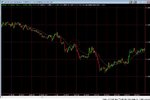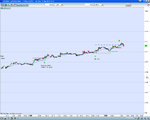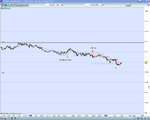You are using an out of date browser. It may not display this or other websites correctly.
You should upgrade or use an alternative browser.
You should upgrade or use an alternative browser.
Giorrgi
Well-known member
- Messages
- 253
- Likes
- 0
One trade for me. Getting rather frustrated at myself.
I almost took it as well but last minute hesitation because of lack of buildup held me back.
ReinLudwig
Junior member
- Messages
- 19
- Likes
- 0
One trade for me. Getting rather frustrated at myself.
I agree, not pulling the trigger can even be more stressful than placing a losing trade!
ReinLudwig
Junior member
- Messages
- 19
- Likes
- 0
Giorrgi
Well-known member
- Messages
- 253
- Likes
- 0
Two trades today.
The second one was wrong, basically I've found out (and it's probably in the book) that the only proper range breaks are those that get at least 2 touches of the barrier line and then break out on the 3rd touch+breach of the barrier. here I traded the breach of a second "touch" of the barrier. By that time it wasn't yet a proper range and there was no "break" to speak of.
The second one was wrong, basically I've found out (and it's probably in the book) that the only proper range breaks are those that get at least 2 touches of the barrier line and then break out on the 3rd touch+breach of the barrier. here I traded the breach of a second "touch" of the barrier. By that time it wasn't yet a proper range and there was no "break" to speak of.
Attachments
ReinLudwig
Junior member
- Messages
- 19
- Likes
- 0
Two trades today.
The second one was wrong, basically I've found out (and it's probably in the book) that the only proper range breaks are those that get at least 2 touches of the barrier line and then break out on the 3rd touch+breach of the barrier. here I traded the breach of a second "touch" of the barrier. By that time it wasn't yet a proper range and there was no "break" to speak of.
It seems to me it's fairly subject to tell when the clustering to the left has an influence on the breakout succeeding or not. Do you have a rule-of-thumb? Can you say, let's say, 1h, or 20 bars, or something? Thanks, rein
Giorrgi
Well-known member
- Messages
- 253
- Likes
- 0
It seems to me it's fairly subject to tell when the clustering to the left has an influence on the breakout succeeding or not. Do you have a rule-of-thumb? Can you say, let's say, 1h, or 20 bars, or something? Thanks, rein
Actually I'm also having some trouble with this clustering issue. In this case (my second chart) it wasn't that bad in hindsight.
Another way of looking at clustering is like at any other level of resistance. When can you say that a given level of resistance has been invalidated? Sometimes only when it is broken.
As per the time span, Volman gives us a clue in his book and in his additional charts: he very rarely looks back further than 2h. So I guess clustering price action further than 2h could be said to have been invalidated. Other than that I cannot offer any real help as I'm not good enough with this method yet.
ReinLudwig
Junior member
- Messages
- 19
- Likes
- 0
Actually I'm also having some trouble with this clustering issue. In this case (my second chart) it wasn't that bad in hindsight.
Another way of looking at clustering is like at any other level of resistance. When can you say that a given level of resistance has been invalidated? Sometimes only when it is broken.
As per the time span, Volman gives us a clue in his book and in his additional charts: he very rarely looks back further than 2h. So I guess clustering price action further than 2h could be said to have been invalidated. Other than that I cannot offer any real help as I'm not good enough with this method yet.
Thank you very much!
BLS
Established member
- Messages
- 642
- Likes
- 229
I was very tempted to take that trade but ended up sitting on my hands. It's looked good to me at the time but I had some doubts about it that I sort of dismissed as fear. Then I had doubts about whether I was overly eager for a trade or not so I did nothing when it broke. I don't have a technical reason for skipping it. In hindsight what you said about the range makes sense but I hesitate to take it as an "absolute". I suppose since we're still in the learning phase that we should try to stick to more rules-based trading to limit the amount of variables that we have to work through to see what works and what doesn't. So it may be a good idea to keep your description in mind as a rule of thumb instead of worrying about being too inflexible.The second one was wrong, basically I've found out (and it's probably in the book) that the only proper range breaks are those that get at least 2 touches of the barrier line and then break out on the 3rd touch+breach of the barrier. here I traded the breach of a second "touch" of the barrier. By that time it wasn't yet a proper range and there was no "break" to speak of.
One trade for me today.
Attachments
Giorrgi
Well-known member
- Messages
- 253
- Likes
- 0
BLS - I feel less bad about that trade now since you hesitated to take it.
Your actual trade is very nice. I hesitated to take that one, I felt like it needed more buildup, but I tend to forget that the better the overall conditions and the action inside the setup is, the less buildup one needs to see. I have to stop thinking "we need 2 dojis before the breakout" all the time and be more flexible. Which comes back to the fact that at some point we will go beyond thinking in terms of absolute rules.
Your actual trade is very nice. I hesitated to take that one, I felt like it needed more buildup, but I tend to forget that the better the overall conditions and the action inside the setup is, the less buildup one needs to see. I have to stop thinking "we need 2 dojis before the breakout" all the time and be more flexible. Which comes back to the fact that at some point we will go beyond thinking in terms of absolute rules.
Giorrgi
Well-known member
- Messages
- 253
- Likes
- 0
Tough day.
The second trade was accidental. I should have waited for the upper barrier line to get taken out (ARB) but instead I clicked when I saw the first line get breached because I was so "concentrated/agitated" about it.
On the third trade there probably wasn't enough buildup but I traded it because I had spent so much time looking at the range that I wanted something out of it. Also I entered with 2 pips slippage
The second trade was accidental. I should have waited for the upper barrier line to get taken out (ARB) but instead I clicked when I saw the first line get breached because I was so "concentrated/agitated" about it.
On the third trade there probably wasn't enough buildup but I traded it because I had spent so much time looking at the range that I wanted something out of it. Also I entered with 2 pips slippage
Attachments
I took the same trade as Gorgio this morning. This is my first week with Pro Real Time charts and I must say the clarity of full pip candles greatly reduces the stress of knowing when exactly to pull the trigger. I am also trading a demo accout with MB trading and the spreads look good. However their platform does not have one click execution and I am having to cope with that. I believe I will be able to find or write an EA for MT4 that will accomplish that. I can't believe how hard it has been to get (A) full pip charting, (B) low dealer spreads, and (C) One click execution with a OCO bracket from the fill. But I'm getting there.
As for the charts, I am using the 70 tick setting . My charts look very much like yours Gorgio, but are not identical. Are you using a 70 tick chart? Or possibly the difference is because I am using their pull through datastream and you may be using the push through variety. I confess I do not know what that means.
As for the charts, I am using the 70 tick setting . My charts look very much like yours Gorgio, but are not identical. Are you using a 70 tick chart? Or possibly the difference is because I am using their pull through datastream and you may be using the push through variety. I confess I do not know what that means.
Attachments
ReinLudwig
Junior member
- Messages
- 19
- Likes
- 0
I have similar observations as datamold. When I compare my tick timeframe in Tradestation against others I do notice differences as well.
I took a SB trade yesterday where I immediately started worrying if I can get to my 10p profit target. I stayed in the trade until I reached the previous swing high, which resulted in +8.5p. However, had I stuck to the rules I probably would have waited, biting my fingernails until eventually reaching my target at the 3rd or one of the subsequent swing highs.
Not sure what your thinking is if you are in a situation like this!?
I took a SB trade yesterday where I immediately started worrying if I can get to my 10p profit target. I stayed in the trade until I reached the previous swing high, which resulted in +8.5p. However, had I stuck to the rules I probably would have waited, biting my fingernails until eventually reaching my target at the 3rd or one of the subsequent swing highs.
Not sure what your thinking is if you are in a situation like this!?
Attachments
Giorrgi
Well-known member
- Messages
- 253
- Likes
- 0
I have similar observations as datamold. When I compare my tick timeframe in Tradestation against others I do notice differences as well.
I took a SB trade yesterday where I immediately started worrying if I can get to my 10p profit target. I stayed in the trade until I reached the previous swing high, which resulted in +8.5p. However, had I stuck to the rules I probably would have waited, biting my fingernails until eventually reaching my target at the 3rd or one of the subsequent swing highs.
Not sure what your thinking is if you are in a situation like this!?
For me, there are now 3 spots where I consider exiting the trade before the target is hit.
1. The tipping point, this is in Bob's book
2. When the way to the target is blocked by a significant line of resistance and prices stall in that area. For example, in a range, I enter an IRB and prices hit the range barrier and then start pulling back. This is subjective since IRBs are sometimes designed precisely to allow you to trade a break that doesn't produce a proper buildup near the barrier range but originates from the middle of the range. However, Bob has pointed out this method in a couple of additional charts he has sent us.
3. When the prices start pulling back after an initial spike and thus start painting a clear double bottom/double top. In your chart there were several prominent tops, however the two tops that followed your entry were higher tops (although by a mere pip or so), then there were another 3 tops before the prices reached target, but these were much less prominent.
It's hard to say if I would have exited before the target was reached as your chart seems to be in pipettes rather than pips so I can't really tell.
Giorrgi
Well-known member
- Messages
- 253
- Likes
- 0
My Friday trade.
A nice double top in the first chart would have helped a lot. I'm finding it very hard to wait for a proper Ww formation (double top / double bottom then some buildup). It is such an easy pattern to recognize, I'm still amazed that I can't just sit there and do only that. I'm sure that it would be enough to make one profitable.
Edit: I've been looking at some of the additional chart bob sent us to check a theory I previously exposed. The theory is that a breach of a barrier line is much more likely to generate a proper break when the barrier line has been tested at least 3 times before the break : 2 times in a big W and another time in a smaller w just before the break. This is not an absolute rule but something that I started noticing. Going through a small sample of Bobs charts I found out that he usually takes trades where the barrier line has been touched 3 times. I will keep going through the charts to check this but so far one interesting chart has retained my attention (chart 23 week 43). In this chart the IRB setup itself displays only two touches of the barrier line just before the break, so basically a small m without the preceding M.
A nice double top in the first chart would have helped a lot. I'm finding it very hard to wait for a proper Ww formation (double top / double bottom then some buildup). It is such an easy pattern to recognize, I'm still amazed that I can't just sit there and do only that. I'm sure that it would be enough to make one profitable.
Edit: I've been looking at some of the additional chart bob sent us to check a theory I previously exposed. The theory is that a breach of a barrier line is much more likely to generate a proper break when the barrier line has been tested at least 3 times before the break : 2 times in a big W and another time in a smaller w just before the break. This is not an absolute rule but something that I started noticing. Going through a small sample of Bobs charts I found out that he usually takes trades where the barrier line has been touched 3 times. I will keep going through the charts to check this but so far one interesting chart has retained my attention (chart 23 week 43). In this chart the IRB setup itself displays only two touches of the barrier line just before the break, so basically a small m without the preceding M.
Attachments
Last edited:
ReinLudwig
Junior member
- Messages
- 19
- Likes
- 0
My Friday trade.
A nice double top in the first chart would have helped a lot. I'm finding it very hard to wait for a proper Ww formation (double top / double bottom then some buildup). It is such an easy pattern to recognize, I'm still amazed that I can't just sit there and do only that. I'm sure that it would be enough to make one profitable.
In your first graph my thinking is that you have a double bottom plus another push down. In essence, the market created a three-push down pattern (kind of a wedge), and a reversal setup (down-up bar) at the third push. So you should expect a two leg up movement; the end of the first leg being exactly where you went short.
I often catch myself fitting in a trendline, trying to determine where this trendline is first broken to the upside before prices reverse down again to test the extreme and then take off to the upside. Al Brooks calls this a major trend reversal (MTR) setup.
This was a tough trading range!
I have similar observations as datamold. When I compare my tick timeframe in Tradestation against others I do notice differences as well.
I took a SB trade yesterday where I immediately started worrying if I can get to my 10p profit target. I stayed in the trade until I reached the previous swing high, which resulted in +8.5p. However, had I stuck to the rules I probably would have waited, biting my fingernails until eventually reaching my target at the 3rd or one of the subsequent swing highs.
Not sure what your thinking is if you are in a situation like this!?
For what it's worth I use 35 tick bars in Tradestation. It very closely mirrors the PRT 70 tick charts.
BLS
Established member
- Messages
- 642
- Likes
- 229
Week 15 charts from Volman posted
https://www.dropbox.com/sh/1amxmi9af0fk6ej/VA5_ZrjQF1
https://www.dropbox.com/sh/1amxmi9af0fk6ej/VA5_ZrjQF1
matty_dunn
Active member
- Messages
- 188
- Likes
- 17
Week 15 charts from Volman posted
https://www.dropbox.com/sh/1amxmi9af0fk6ej/VA5_ZrjQF1
Thanks Bob and BLS
Similar threads
- Replies
- 0
- Views
- 2K
- Replies
- 2
- Views
- 2K
- Replies
- 11
- Views
- 9K



















